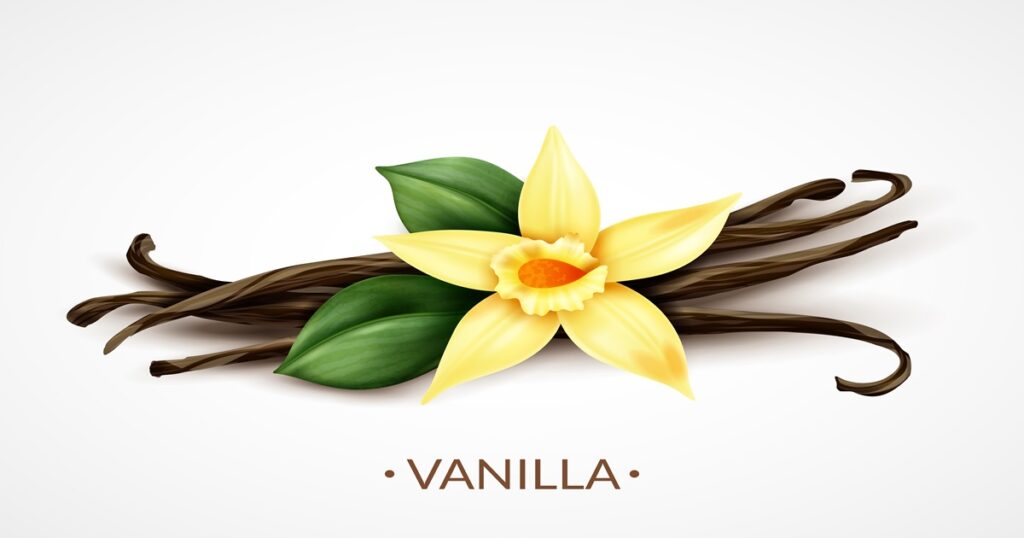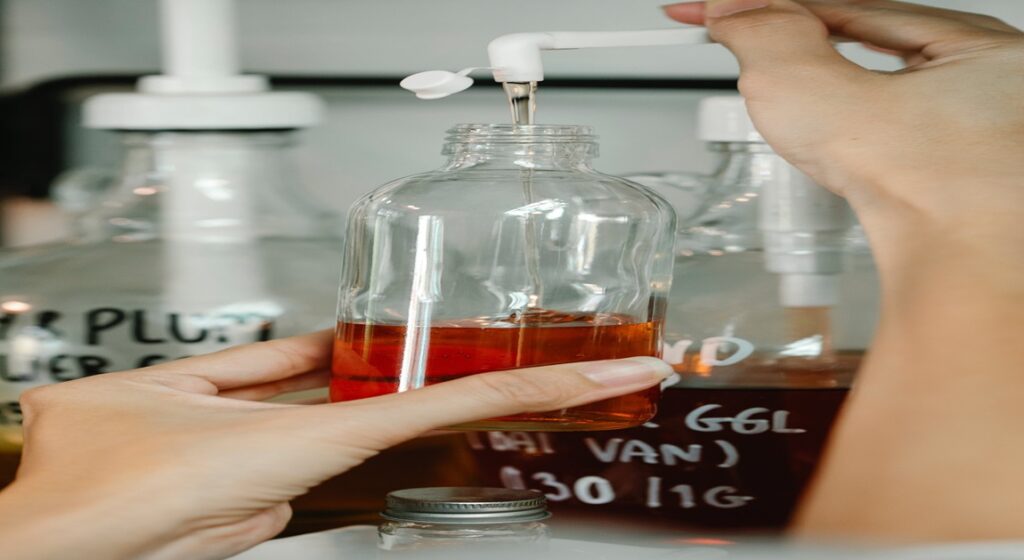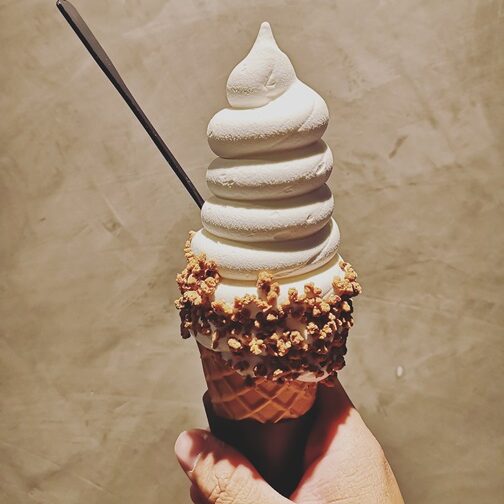Introduction
Have you ever been fascinated with the fragrant and sweet appeal of vanilla and wondered how vanilla flavour is made? You are not alone, though. As we dive deeply into the science behind the fascinating world of vanilla flavor, get ready for an exciting adventure.
Vanilla has a unique place in our hearts and palates due to its delicious flavour and appealing aroma. This unique flavouring agent comes from the genus Vanilla orchid, attracts our senses and takes our favourite recipes to new heights. It’s the aroma that rises from just-baked cakes, the fragrance that transform a basic dessert to the delicious one.
This article tells you what is vanilla flavour, its sources, how it is made and extracted, all about its production which creates motivation to explore its complexities, and eventually highlight the advantages of understanding this seemingly straightforward but extremely complex essence. As I reveal the science behind what makes vanilla a culinary wonder, get ready to develop a deeper appreciation for the amazing world of vanilla.
What is vanilla flavour?
We all heard about vanilla flavour but many of us don’t know that vanilla is a spice derived from orchids of the genus Vanilla, primarily obtained from pods of the flat-leaved vanilla.

How to make vanilla flavour naturally?
Natural vanillin (4-hydroxy-3-methoxybenzaldehyde) is one of the most common flavour chemicals and is used in a broad range of flavours. It occurs in the vanilla bean at a level of 20g/kg dry weight and is associated with many other compounds.
Approximately 12000 tons of vanillin is consumed annually, of which only 20 tons is extracted from vanilla beans; the rest is produced synthetically, mostly from petrochemicals such as guaiacol and lignin.
During the past few years there has been considerable commercial interest in producing vanillin from natural raw materials using biocatalysis. In the biodegradation of several natural compounds, such as stilbenes, eugenol, ferulic acid, and lignin, vanillin is a metabolic intermediary.
Natural vanilla is a mixture of flavour components extracted from the cured beans of the vanilla plant: V planifolia and V tahitensis. There are currently over 170 recognized volatile aromatic components. The components of vanilla flavour are vanillin, vanillic acid, vanillyl alcohol, p-hydroxybenzaldehyde, p-hydroxybenzoic acid and p-hydroxybenzylalcohol.
What is the difference between vanilla extract and vanilla essence?
Vanilla Extract is the most natural form of vanilla. It is prepared by concentrating the active components of vanilla. While it is three times more expensive than vanilla essence, its unmatched quality makes it worth the investment. Always keep in mind that vanilla extract is not bake-stable and should be added after the food is removed from heat.
Vanilla Essence: A more affordable option to pure vanilla extract is vanilla essence, a commercially produced mixture of high-quality ingredients and vanilla beans.

It is bake-stable and requires only a few drops to infuse your baked creations with its delightful aroma and flavour. This essence consists of a solution of synthetic vanillin in ethanol. Vanillin (4-hydroxy-3-methoxybenzaldehyde) is the primary flavouring ingredient in cured vanilla beans and plays a significant role in the distinctive flavour and scent of real vanilla.
How is vanilla flavour extracted?
The two source of vanilla flavour is natural and synthetic.
Vanilla orchid when pollinated produces a pod containing vanilla beans. These beans are cured and fermented. After fermentation beans are grounded and soaked in alcohol and water to create liquid extract. This way we get the natural vanilla flavour.
By refining petrochemicals artificial vanilla flavour can be made. When vanillylmandelic acid reacts with oxygen, synthetic vanillin produces. Vanillin is the main ingredient in artificial vanilla. Any extract made from the petrochemical technique is known as artificial vanilla extract.
Vanilla can also be made from fungi, such as yeast. By genetically modifying the yeast, vanilla flavour may be produced from sugar. According to federal regulations, you can refer to it as natural flavouring because it comes from an organism. Yeast or fungal-based vanilla extract not used in the baked goods. It is used to add flavour to ice cream.
How vanilla flavour is made in India?
In 1999, 37,525 hectares of vanilla were cultivated worldwide, yielding 4403 tonnes of production. The main countries that produce vanilla are Madagascar, Indonesia, Mexico, Reunion and Comoros.
Since the early 1990s, Kerala, Karnataka, and Tamilnadu have seen considerable increase in the cultivation of vanilla. Currently, around 1000 hectares are under cultivation, of which 30 percent have begun to yield. It is estimated that India produces 6–8 tonnes of processed vanilla annually.
Four major types of vanilla beans-
- The Bourbon Vanilla
- The Java Vanilla
- The Bourbon-like Vanilla
- Mexican Vanilla
The conditions of growth, harvesting, and curing lead to variations in their flavours and organoleptic characteristics. The best vanilla is the Bourbon vanilla.
Small and marginal growers in India are the main producers of vanilla, interplanting it with other crops in their farms. Although it is not certified, it is primarily farmed in organic conditions.
The extraction of vanilla flavour is a careful process that involves these stages:
-Harvesting of beans
-Curing of beans
-Extraction of flavour
Commercial Extraction of vanilla flavour
Have you ever wondered where does vanilla flavour come from? The truth is that the flavour is extracted from the cured bean using a variety of techniques.
There are two types of vanilla extraction techniques: the oleoresin method and the percolation method
The percolation method: It consists of circulating a solvent over and through the beans under vacuum, which is an ethanol/water solution in the range 35-50:65-50 (v/v). This process can take from 48 to 72h. From this process, an approximately fourfold strength vanillin can be produced.
The oleoresin method: Using the oleoresin process, whole beans are ground up and then ethanol is circulated over them at a temperature about 45°C, under vacuum. Evaporation is done to remove the extra alcohol. About 8±9 days require for this process.
Vanillin, obtained is approximately ten-fold strength by using the oleoresin technique. Natural vanillin is marketed as a diluted ethanolic extract in the commercial sector. After extraction, the extract is aged for a year before being clarified by centrifugation or filtration.
Uses of vanilla

- Vanilla is famous for sweetened foods
- Vanilla sugar is used in the production of chocolates
- Vanilla flavourings are used in commercial products like in liquors, cheap brandy and whisky.
- Pure vanilla extracts are used as a flavouring for ice cream, soft drinks, chocolate, confectionery, candy, baked foods, puddings, cakes, cookies
- Vanilla flavour is also used as a fragrance ingredient in perfumery
- It enhances the flavour of caramel, coffee and some dairy products
- It is used in spice oleoresin formulations, sausages, seasonings
Conclusion
Many of us considered vanilla flavour is simple or boring but it is popular all over the world. It is mostly used due to its sweet, creamy and floral notes. I have tried to cover all the aspects of how to extract vanilla flavour and how it is made. Hope you will find this article helpful and informational.
If you are interested in food flavours, read my another article on Flavouring Agents in Food.